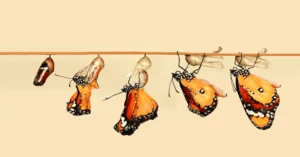AI Answer Evaluation Platform Live Now. Try Free Answer Evaluation Now
Theory of Spontaneous Generation
What is the ‘theory of spontaneous generation’?
Since ancient antiquity humankind has inquired into the origins of life forms. What Greek philosopher Aristotle proposed in 350 BC established a set of explanations to such phenomena. The theory of spontaneous generation is the idea that living organisms originated from seemingly non-living beings, or even totally inorganic matter. These ideas were used to explain the sudden presence of fish and frogs in puddles of water, maggots on meat and other bizarre ‘creations’ like scorpions born from basil and mice from wet rags in a granary.[1]

To one’s total dismay, these theories stuck on till about the 17th century until a number of experiments stood to refute them.
Challenging the theory
Beginning in 1665 with the popularity of the microscope, early research by Robert Hooke and van Leeuwenhoek had introduced microbiological phenomena like spores, fungi and germs to mainstream science.[2] Following that, scientists of that era began probing into the possibility of life beyond what is visible to the naked eye. Moreover, one of the ways to refute spontaneous generation was to debunk the series of bogus explanations of ‘sudden life’ that existed for millenia in a systematic or scientific way.
Maggots from Rotting Meat
In 1668, Italian physician Francesco Redi placed meat in six jars which were either sealed, open or partially sealed. Over-time, maggots appeared inside the open jars and not on the sealed ones. Subsequently to facilitate air, Redi placed a cloth on the jar which resulted in maggots appearing on the cloth. This led Redi to hypothesise that the source of maggots were in fact flies who laid eggs from which the maggot worms hatched. The disconnect between flies and meat guaranteed the absence of maggots.
Following Redi’s experiment, naturalists continued to believe that spontaneous generation occurred among parasitic worms and microorganisms, but seldom so in larger beings.[3]
The ‘Broth’ experiment
John Needham was an advocate of the theory of spontaneous generation. In 1745, he attempted to validate the theory by demonstrating an experiment of boiling some broth(to kill all the microbes) containing either meat or vegetables and then presenting ‘spontaneously generated’ microorganisms after sealing the pot.
Lazzaro Spallanzani challenged Needham through hundreds of similar experiments.[4] He pointed toward the time between boiling and sealing as the foremost cause of microorganisms being introduced from the air, midway through the experiment. In Spallanzani’s experiment, no spontaneous growth was observed if the broth was sealed before boiling.
However, Needham responded with a valid argument for air as a ‘necessity for introducing or sustaining life’. This debate allowed the theory to survive well into the early 19th century. [3]
Pasteur’s Final Blow
In the wake of Darwin’s evolution and his apparent refusal to address the theory of spontaneous generation[3], Lamarckism had also gained massive support. This era was marked by a growing shift toward understanding germs and molecules. Moreover, the progression of life’s complex and simple forms were being explored by scientists.
Louis Pasteur was a French chemist and a stalwart researcher of microbial fermentation. His focus toward refuting spontaneous generation came by accepting a challenge from the Paris Academy of Sciences in 1858. Pasteur demonstrated the broth experiment using ‘swan-shaped’ flasks.
Pasteur’s flasks allowed air to flow, however due to the twisted neck, airborne organisms were barred entry into the broth. This proved that for months, a sterile broth would be absent of any microbial growth and in fact air was responsible for introducing ‘new life’ from the outside, even in the experiments of Needham and Spallanzani. Pasteur had thus disproved the theory of spontaneous generation.
Aftermath
Louis Pasteur’s work later solidified the germ theory of diseases which highlighted food contamination by bacteria instead of spontaneous generation. John Tyndall famously advocated these views in his seminal 1870 lecture – Dust and Disease.[5]
The debates still ensued following revived interest by Ferdinand Cohn, who in 1876 observed heat resistant endospores capable of withstanding immense heat or boiling.
Moreover, with the introduction of the Watson-Crick DNA structure, focus shifted to a chemical-based origin for all life. Soviet biochemist A.I. Oparin opposed these notions with a more gradualistic view of chemical evolution rather than a single[6] ‘living molecule’. These views were tarnished due to their place in the Lysenko-dominated Soviet genetics.
In the current age, scientists and scholars disenfranchise the credibility of any life emerging from non-life. The impact of genetic studies, modern synthesis and evolutionary paradigms have firmly asserted ‘complex life originating from simpler life’. The theory of spontaneous generation as Louis Pasteur says, has experienced a ‘mortal blow’ in the eyes of mainstream science.
References
[1] Pasteur, Louis (7 April 1864). “On Spontaneous Generation” (PDF) (Address delivered by Louis Pasteur at the “Sorbonne Scientific Soirée”). Archived from the original (PDF) on 26 March 2009. Retrieved 1 July 2009.
[2] Gest H. 2004 The discovery of microorganisms by Robert Hooke and Antoni van Leeuwenhoek, Fellows of The Royal SocietyNotes Rec. R. Soc. Lond.58187–201 http://doi.org/10.1098/rsnr.2004.0055
[3] Strick, James. (2009). Spontaneous Generation. 10.1016/B978-012373944-5.00326-6.
[4] R. Mancini, M. Nigro, G. Ippolito. “Lazzaro Spallanzani and His Refutation of the Theory of Spontaneous Generation.” Le Infezioni in Medicina 15 no. 3 (2007):199–206.
[5] Tyndall J. Dust and Disease. Br Med J. 1871 Jun 24;1(547):661-2. doi: 10.1136/bmj.1.547.661. PMID: 20746278; PMCID: PMC2260786.
[6] Oparin, A. I. “The origin of life”, translation by Ann Synge. In: Bernal, J. D. (ed.), The origin of life, Weidenfeld & Nicolson, London, 1967, p. 199–234.




